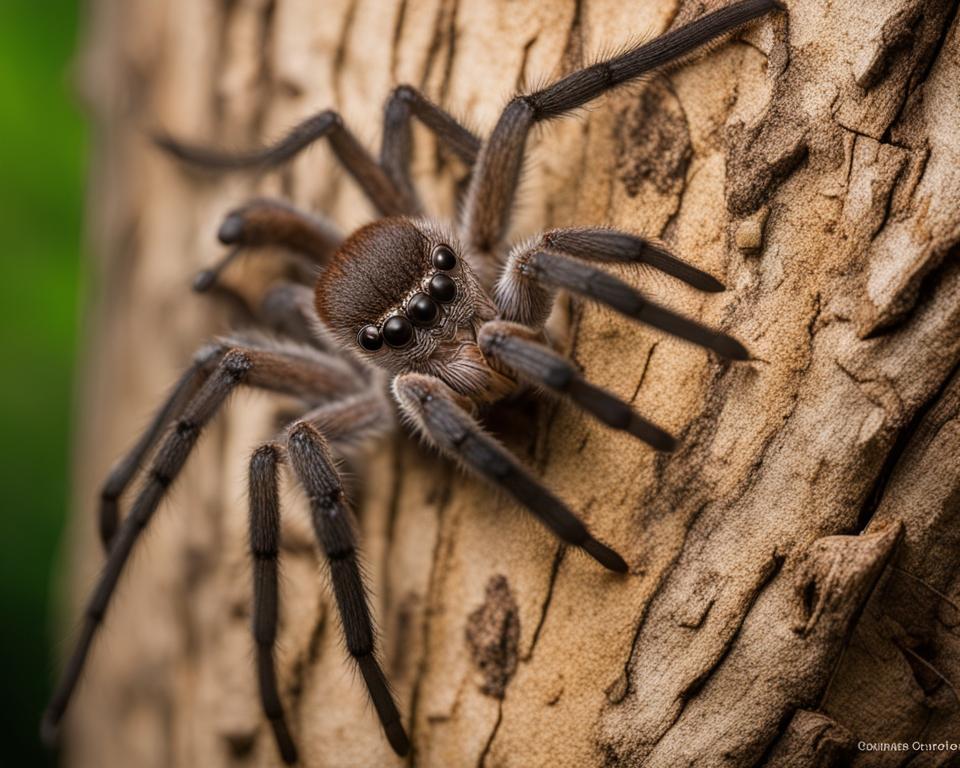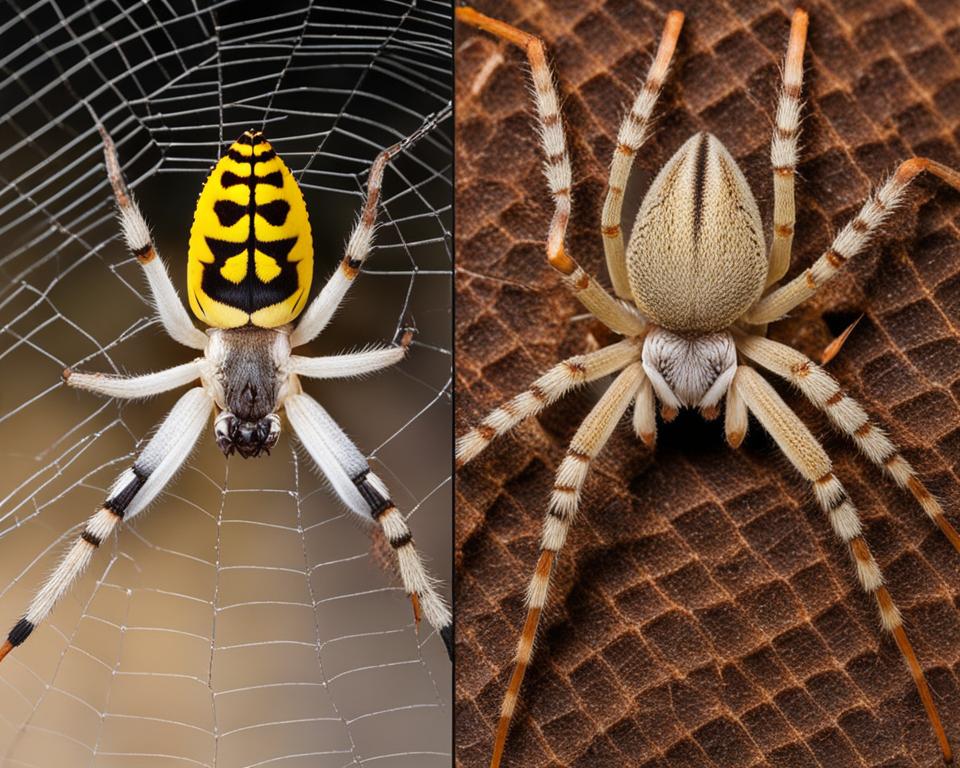Spiders are fascinating creatures with unique traits and behaviors that set them apart from one another. Huntsman spiders and banana spiders are two such species that have captured the interest of many people. While they may appear similar at first glance, there are significant differences between the two.
Key Takeaways
- Huntsman spiders and banana spiders are two distinct species with unique physical and behavioral characteristics.
- Understanding their habitat preferences, diet, and hunting techniques can help differentiate the two spider species.
- Both species are important to the ecosystem and contribute to the biodiversity of their respective habitats.
Habitat and Behavior
Huntsman spiders and banana spiders have different habitat preferences and distinctive behaviors that set them apart from each other. Understanding these factors is crucial in distinguishing the two species.
Habitat of Huntsman Spider
Huntsman spiders are known for their adaptability, allowing them to thrive in various environments. They are commonly found in tropical and subtropical regions around the world, including North, Central, and South America, Asia, and Australia. Huntsman spiders are frequently discovered in warm, dry, and sheltered environments such as under bark, inside buildings, and on foliage.

Habitat of Banana Spider
Banana spiders are primarily found in tropical regions, including Central and South America, the Caribbean, and southern North America. They prefer moist environments and can be found in forests, gardens, and fields. Banana spiders are known for weaving large webs in open areas, such as between trees and bushes.
Behavior of Huntsman Spider
Huntsman spiders are active hunters that rely on speed and agility to capture prey. They are nocturnal and prefer to hunt at night, hiding during the day. Huntsman spiders are also known for their ability to flatten and camouflaging themselves against surfaces to avoid detection. They can move sideways and backwards, making them excellent climbers.
Behavior of Banana Spider
Banana spiders are passive hunters that rely on their webs to catch prey. They are diurnal and typically hunt during the day when their webs are more visible. Banana spiders are not aggressive towards humans, but they can bite if provoked.
Physical Characteristics
Huntsman spiders and banana spiders have unique physical characteristics that distinguish them from other spider species.
Huntsman Spider Characteristics
Huntsman spiders are large, fast-moving spiders with long, thin legs and a flattened body. They have eight eyes arranged in two rows and are typically brown or grey in color. These spiders can measure up to 30 centimeters in leg span, making them one of the biggest spiders in the world.
Huntsman spiders get their name from their hunting style. They don’t spin webs to catch prey. Instead, they chase and pounce on their prey.
Banana Spider Features
Banana spiders, also known as golden orb-weavers, are known for their striking yellow or golden coloration. They have bulbous, shiny abdomens and long, spindly legs. Their webs are large and intricate and can measure several feet across. These spiders can reach up to 5 inches in leg span, making them one of the largest orb-weaving spiders.
Banana spiders are known for their impressive silk-weaving abilities. They spin webs that are incredibly strong and durable, allowing them to catch larger prey like birds and bats.

The physical characteristics of huntsman and banana spiders are unique and easy to distinguish. By understanding their features, you can easily identify which species you are encountering.
Diet and Hunting Techniques
When it comes to diet, huntsman spiders and banana spiders have different preferences. Huntsman spiders tend to feed on insects and other spiders, while banana spiders are known to consume a variety of insects, including flies, mosquitoes, and grasshoppers.
In terms of hunting techniques, huntsman spiders use their speed to outrun their prey, while banana spiders rely on their webs to ensnare insects. Huntsman spiders can also use stealth and camouflage to capture their prey, while banana spiders are known to actively patrol their webs for potential meals.
It is interesting to note that despite their differing hunting techniques, both huntsman spiders and banana spiders are effective predators in their respective habitats.
Conclusion
Congrats on completing this article on the differences between the huntsman spider and the banana spider! By examining their habitat preferences, behaviors, physical characteristics, and diet, we have identified numerous variations between these two spiders.
Firstly, the hunting techniques of these spiders differ significantly. Huntsman spiders are active hunters, while banana spiders wait patiently for their prey to come to them. Additionally, these spiders vary in their habitats, with huntsman spiders found in various areas worldwide, while banana spiders are mainly found in Central and South America.
Moreover, the physical characteristics of these spiders differ significantly. Huntsman spiders have a flattened and elongated body that helps them navigate tight spaces, whereas banana spiders have a more rounded abdomen that is used for spinning their webs.
Lastly, these spiders have distinct diets. Huntsman spiders prefer to feed on insects, while banana spiders consume primarily other spiders and insects.
By comparing and contrasting these spiders, we can appreciate the unique qualities of each species. Whether you encounter a huntsman spider or a banana spider, you now know how to distinguish between the two and appreciate their unique characteristics.
FAQ
Are huntsman spiders and banana spiders the same?
No, huntsman spiders and banana spiders are different species of spiders with distinct characteristics and behaviors. While they may share similarities in their appearance, they have several key differences that set them apart.
What are the main differences between huntsman spiders and banana spiders?
The main differences between huntsman spiders and banana spiders lie in their habitat preferences, behaviors, physical characteristics, and diet. Huntsman spiders are typically found in warm and tropical regions, whereas banana spiders are commonly found in tropical rainforests. Huntsman spiders have longer legs and a relatively flat body, while banana spiders have a larger and more noticeable abdomen. In terms of behavior, huntsman spiders are known for being fast and agile hunters, while banana spiders are known for their intricate web-building skills. Lastly, their diet differs, with huntsman spiders primarily feeding on insects and other arthropods, while banana spiders primarily feed on other spiders and small insects.
What are the preferred habitats of huntsman spiders and banana spiders?
Huntsman spiders prefer warm and tropical environments, such as forests, gardens, and homes. They are commonly found hiding in tree bark, under rocks, or in dark corners of buildings. Banana spiders, on the other hand, are most commonly found in tropical rainforests, where they construct their elaborate webs within the vegetation to capture prey.
How do huntsman spiders and banana spiders behave differently?
Huntsman spiders are known for their exceptional speed and agility, allowing them to chase down their prey actively. They are also known to be more active during the night. In contrast, banana spiders are skilled web-builders, constructing large orb-shaped webs to capture flying insects. They are sedentary hunters, patiently waiting for prey to become entangled in their silk strands.
What physical characteristics distinguish huntsman spiders from banana spiders?
Huntsman spiders have long legs that are adapted for quick movement and climbing. They have a relatively flat body shape and can vary in color, often blending with their surroundings. Banana spiders, on the other hand, have a larger and more noticeable abdomen, which is often brightly colored with distinct markings. They have relatively shorter legs compared to huntsman spiders.
What do huntsman spiders and banana spiders eat?
Huntsman spiders primarily feed on insects and other arthropods, such as beetles, cockroaches, and grasshoppers. They are also known to prey on other spiders and small lizards. In contrast, banana spiders mainly feed on other spiders, as well as small insects that get trapped in their webs.
